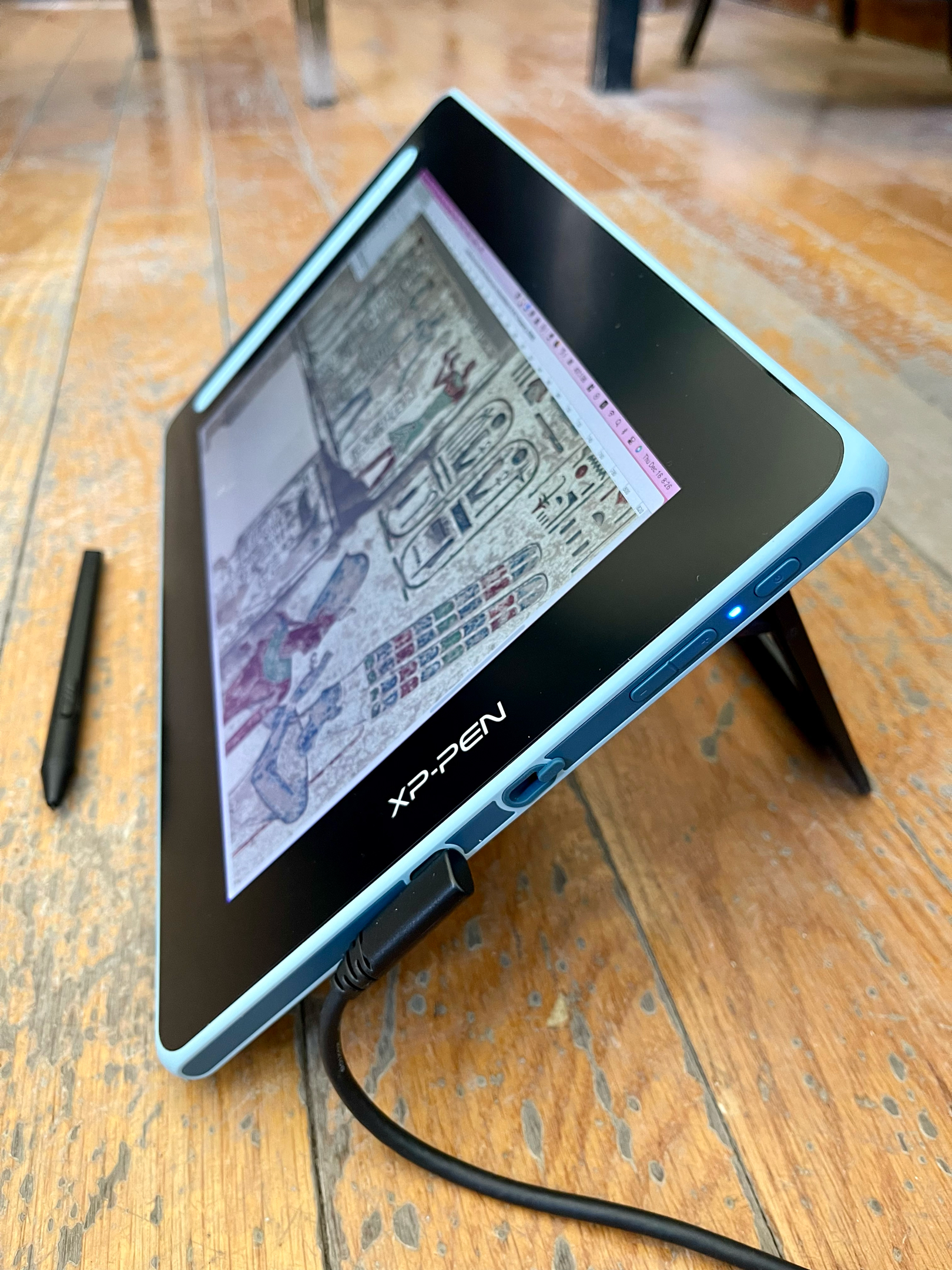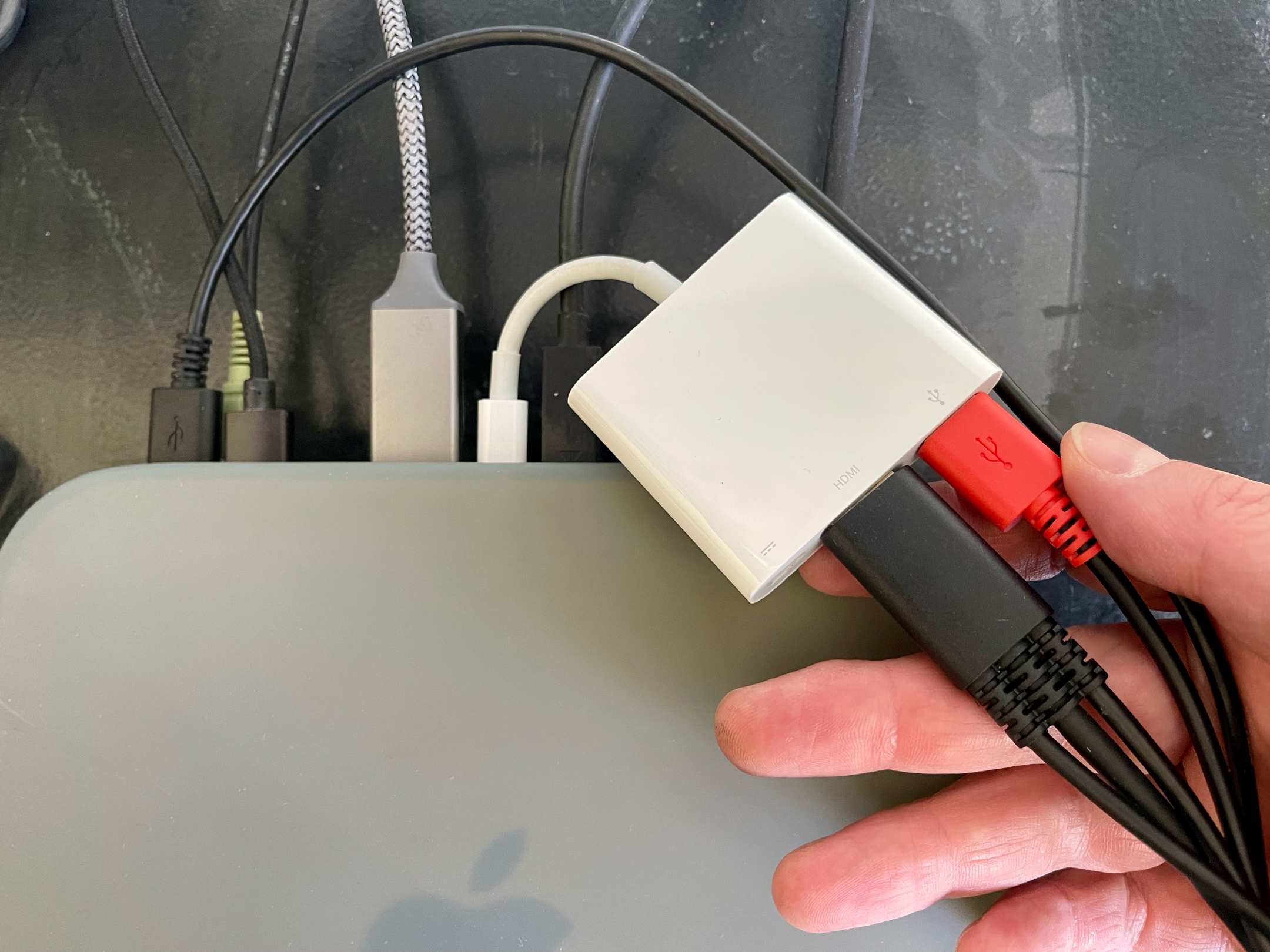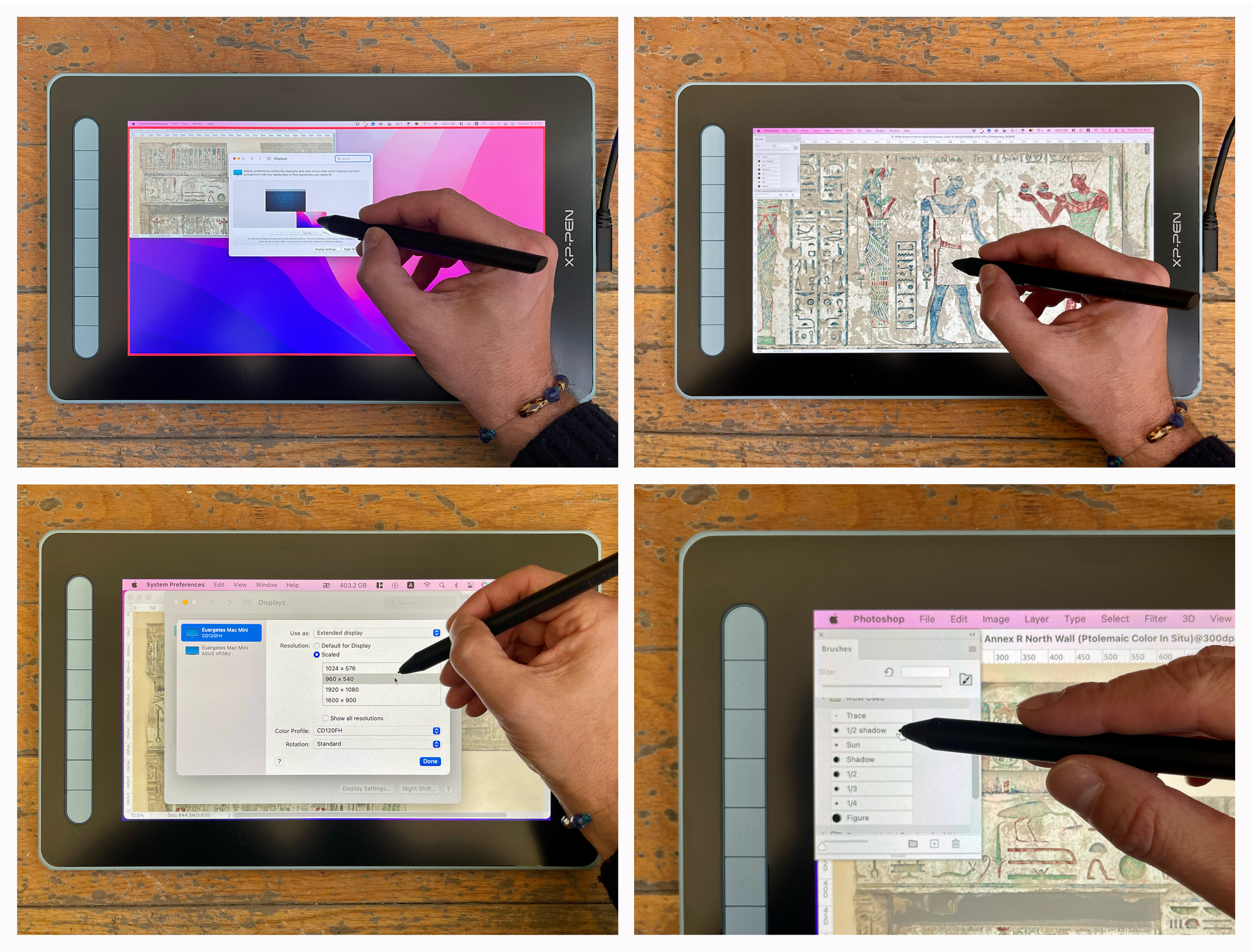Digital Inking on the Move Part 1 - XP-PEN Artist 12 2nd Generation Review
For this review, XP-Pen was kind enough to supply digitalEPIGRAPHY an XP-PEN Artist 12 (2nd Generation).

The author inking in 2012 on a Wacom Cintiq 22HD at the Epigraphic Survey's Luxor field headquarters
Continuous access to desktop Photoshop, the Survey's software of choice for digital inking, is crucial for the artist, as digital line drawings are often corrected in the field studios. While having a large-screen, full-fledged pen display (such as XP-PEN's Artist Pro 24) at home is desirable, the past two years have shown that maintaining the same heavy-duty devices in the field can be problematic in the long term. The worldwide pandemic has brought several operational changes to the Epigraphic Survey's fieldwork. Last year, their documentation program couldn't be resumed at the monuments, forcing the Survey to restructure some of their core procedures and set about to "rationalize" field equipment. A logical step was to move towards more versatile mobile devices to be applied at archaeological sites. Thinking along these lines for some time now, they've had tremendous success using Apple's iPad Pro in the field, as digitalEPIGRAPHY reported on numerous occasions. With the iPad Pro being indispensable for digital "penciling," it was only natural for the Survey to find additional purpose for their tablets, using them as studio devices for more demanding work while in Egypt.
There are, of course, many candidates to provide a small, versatile drawing display for digital inking on the move. For a start, Wacom's One is a well-positioned entry into the budget drawing tablet market that costs only $400. At 13 Inches, it is the same size as Wacom's aging Cintiq Pro 13, which proved to be a hard sell against the iPad Pro 12.9. When measuring up the new One, we must keep in mind that with Wacom's recent budget option, two new lower-cost iPads arrived as well. The 10.2 Inch iPad (from $329) and the 11 Inch iPad Air (from $599) support the Apple Pencil (for an additional $100 or so), providing excellent alternatives for epigraphers looking for their next drawing tablet. iPad applications like Duet and especially Astropad mimic the functionality of a dedicated pen display. Additionally, Apple now allows iPads to be used as dual screens for newer Macs with the addition of Sidecar, a feature baked in their more recent operating systems.
Nonetheless, there is a notable disadvantage affecting the use of iPads as pen displays for the precise line placement that digital inking demands. The main difference between using dedicated pen displays versus the iPad is their screen technology and pen design. Pen displays have passive pens that work using entirely the EMR waves of the tablet, and therefore contain no battery and have no need to be recharged. On the other hand, the iPad's Apple Pencil is an active stylus that needs to be recharged regularly. More importantly, Apple's Pencil cannot register an input until touching the screen. Moving the cursor is more involved and less fluid than on a pen display, which can "see" the pen while hovering above the screen. The iPad's behavior can be off-putting for some artists, looking for the level of accuracy their home studio equipment provides. No wonder that in digitalEPIGRAPHY's most recent review, the emphasis is on one of our favorite drawing display maker's brand-new stylus and the technology behind it.
The review of XP-PEN's 2nd Generation Artist 12 pen display is aimed at those colleagues not wanting to learn new tricks regarding pen performance (i.e., don't want to use an iPad for digital inking) but instead are looking for an affordable and versatile mobile extension of their established studio drawing practices.
Hardware and Connection

The new Artist 12 is 346.2 x 209 mm (13.6 x 8.2 inches) with a 263.23 x 148.07 mm (11.9 inch) screen area. The device is only 12 mm thick
Upon opening the small box the Artist 12 arrives in, there is an instant feeling of "neatness" to all the individually packaged components. The Pen display has a rugged edge highlighted by the blue accent color that is just one of the four possible flavors offered by XP-PEN (the others being green, pink, and the more conservative black). The casing is aluminum with a premium feel, providing durability to the tablet. Holding in hand, it proves to be light and small enough to be tossed in a suitcase. But one must protect the screen while doing so as the entire surface is one continuous glass panel apart from the hotkeys occupying one of the narrower sides.

The iPad Pro 12.9 (left) is all screen with a 4:3 aspect ratio that provides a lot more canvas area in a smaller chassis than the 12-inch XP-PEN Artist 12 (right), with its 16:9 ratio encompassed by large bezels.
There is a generous bezel around the screen, causing the little Artist 12 to have a much larger footprint than the iPad Pro. Nonetheless, this seemingly obtrusive bezel provides much better grip and arm support for precise line placement when it comes to digital inking. On the other hand, drawing close to the edges on Apple's tablet is essentially impossible without an easel. There are eight shortcut buttons on the display that can be programmed to carry out simple tasks as one would expect on such devices. They don't wobble, are large, and have a delightful, rubbery feel with a satisfying click when pressed. XP-PEN's attractive design and attention to detail are admirable, especially considering the company's target user base at this price point.

We at digitalEPIGRAPHY are in a fortunate situation. Since the Epigraphic Survey began experimenting with utilizing digital tools in their documentation process, the computer industry has been in full swing producing better and better hardware for creating digital art. While years ago, when one needed a reliable, precise and well-made drawing display, there was Wacom and… well, Wacom. Nowadays the picture is not that clear anymore. New/old contenders that used to produce “budget” options are reinventing themselves, creating better and better displays where quality and affordability are not at the opposite end of the scale anymore. One such notable player is XP-PEN, a company founded in Japan, celebrating its 15th anniversary of constructing digital canvases for artists, graphic designers and alike. This is not our first review unit produced by the company. Towards the end of 2019, we had the pleasure to play with the XP-PEN Artist 15.6 Pro and we walked away really impressed, wishing for the company not to lose focus on what works and improve on the few things that don’t. Not incidentally, their brand-new Innovator 16 can be regarded as the next iteration of said tablet, with a renewed focus on build quality and usability improvements. Read the full article here!

The Artist 12 doesn't come with a built-in kickstand. To prop up the tablet while drawing, one must purchase one of XP-PEN's stands or opt for a second-hand option.
On the right side, you'll find several buttons and connectivity options. There is the power and a pair of dedicated brightness buttons starting from the top. Below are two USB-C ports connecting the pen display to the computer. While the little Artist 12 is compatible with most modern Macs, Windows, and Linux computers (and even works with Android OS to a certain degree), only one type of connection is supported right out of the box. While we respect XP-PEN's desire to keep the price as low as possible, not providing a USB-C to USB-C cable with the tablet seems like an oversight, especially considering the confusing arsenal of USB-C cables available for purchase. No matter how many USB-C to USB-C charging cables you own, only cables with power, video, AND data functions can provide elegant single plug connectivity to the Artist 12. Of course, none of the iPad Pro's charging cables work here. In our case, Wacom's data cable came to the rescue. If you don't have such luck, XP-PEN offers the kind you'll need (1.5 m long) for an additional $15.99. Bummer.

Cables, cables, and more cables. The little XP-PEN is no exception when it comes to connectivity wrinkles. We can't wait to see these companies produce rechargeable, wireless pen displays!
Going back to what is included in the box, we are looking at a three-way connectivity/charging cable that is USB-C on the display's end and has a separate HDMI and two USB-A (power and data) plugs on the other. When all of these are connected to our M1 Mac Mini there is no room for much else, preventing the Artist 12 from being used in tandem with a large screen monitor (more on that later). As a workaround, Apple's USB-C Digital AV Multiport Adapter ($69) can spare the HDMI port. However, we'd recommend buying a USB-C video cable instead, unless you already own Apple's adapter. Needless to say, you also need to have a computer capable connecting to a display via USB Type-C.

Connecting the tablet with the included cable can be cumbersome and certainly defies the idea of mobility.
However, once you figure out the most suitable connection for your gear, you get a competent all-around pen display that can be positioned anywhere on your table, thanks to its relatively small footprint.
Software and Performance
Setting up the Artist 12 happens through XP-PEN's driver that must be downloaded from the company's website to get the tablet up and running. There are separate drivers available for Windows, macOS, and Linux that slightly differ in their customization options. The process is straightforward and requires only a few minutes of your time before the display is ready to accept the first brush strokes. Before getting into button customization, we must stop for a second and look at screen resolution. The Artist 12 has a fully laminated (no gap between the cursor and the pen tip) Full HD (1920 x 1080 pixels) screen, making brushstrokes look sharp at this relatively small display size. However, using the tablet at this resolution causes software user interface elements to appear reasonably small, with Photoshop menu items essentially unreadable at times. XP-PEN probably had the same concerns determining the default at a much lower resolution. Following the "stock" option results in a magnified UI that is more usable but allows less canvas space. Working with such a small device arrives with its compromises.

Setting up the correct screen resolution for your projects is key to productivity as the 12-Inch screen can be somewhat claustrophobic at times.
The driver functions as expected, allowing pen calibration, canvas area and pen pressure customization, and setting up the dedicated shortcut buttons. Of those, we get eight on the tablet and an additional two on the pen. The uniform-looking tablet buttons have protruding patterns on the surface for easier maneuvering. Suppose you need to add more shortcut functionality to your daily drawing chores. In that case, you can either opt for a dedicated shortcut device or upgrade to XP-PEN’s Artist 13 Pro that has a larger screen and an excellent multifunctional dial.
Customizing the Artist 12 (2nd Generation)
And now, let's talk about the "X3 Elite" stylus, the brand-new battery-free pen that comes with the tablet. According to XP-PEN's marketing material, it reacts to as little as 3 grams of activation force with ten times better sensitivity, so "artwork can be produced with a featherlight stroke." While we don't have the tools to confirm these numbers, XP-PEN's new pen technology has definitely improved over previous iterations. The nib has less retraction (only 0.6 mm according to the company) when pressed against the screen, and lines appear instantly upon the slightest touch of the surface. The pen is also very light and handles perfectly. This new chip technology certainly makes the stylus very responsive that shows while carefully crafting sun-shadow ink line transitions or adding rapid brush strokes for color texturing. The new pen is combined with virtually no parallax and just enough screen resolution, allowing the artist to achieve exact line placement when needed! We're also pleased to report that tapering when using pressure-sensitive brushes (like the brushes designed for digital color penciling) is just perfect. This is a huge relief, and kudos to XP-PEN for their new pen, especially compared to similar devices at this price point.

There is no stuttering or line jitter to fine ink lines, a problem that plagued some previous non-Wacom devices we've tested over the years.
It must be mentioned that XP-PEN's new Artist Pro 16, based on the design language of the groundbreaking Innovator 16 tested by digitalEPIGRAPHY, is the only other pen display employing the X3 pen technology for now. We'd go as far as advising our readers, eyeing XP-PEN's larger displays, to hold off their purchases until they come with the X3 Elite. The new stylus is that good.
Drawing Experience

The physical side buttons can quickly adjust screen brightness. Providing instant access to such a feature can be helpful if you work under various light conditions.
Drawing experience is always based on many contributing factors. How unobtrusive and flexible the hardware is, how large the provided drawing area is, how many and what kind of shortcut options are available, how good the stylus is, and how bright and clear the screen is. Most of these elements have already been discussed, except screen performance. The XP-PEN Artist 12 immediately strikes us with its vibrant screen that can be adjusted to 220 cd/m2. Color temperature, RGB, and contrast ratio (maxing out at an average of 1000:1) can be tweaked via the driver under Display settings. These settings are missing in the macOS version of the software but can be adjusted through Displays in System Preferences. According to the company, the new Artist 12 can reproduce 94% of the Adobe RGB color range, equivalent to 90% of NTSC or 127% of sRGB. It is plenty bright compared with a regular monitor. However, in this respect, it is outperformed by the latest iPad Pro. The difference in brightness becomes apparent when the two are put right next to each other. Of course it sounds unfair to compare the 1000-nit micro-LED $2000+ iPad Pro to a $250 pen display. To conclude, the Artist 12 provides enough brightness under most circumstances, leaving some room for future improvement.
On the other hand, the screen response is fantastic, thanks to it being fully laminated, eliminating any air gap between the screen and the touch-sensitive sensor. It can also register up to 60 degrees of tilt, meaning that you can angle the stylus for broader brush strokes while still maintaining a fine line. The pen registers 8192 different pressure levels, measuring up to the current standard for pen displays.

One constantly wants to crank up the brightness when switching to the XP-PEN Artist 12 after using the iPad Pro. This is not to downplay the XP-PEN’s vividness but to praise Apple’s latest tablet.
If possible, we recommend using the little XP-PEN in tandem with a much larger desk monitor when getting to the actual drawing process. There are several 27–32-inch screen options for a moderate price available in Egypt that can be added to your setup as a long time investment. Having a large screen in front of you with a duplicate canvas (Photoshop / Window / Arrange / New Window for or CTRL+CMD+N) open in Photoshop is a massive upgrade for the usability of the Artist 12 as a digital inking machine. With the said arrangement, one can have a magnified portion of the canvas open on the tablet, maximizing the drawing area while keeping a much larger segment within sight.

One can maximize the screen real estate by moving only the canvas and project-specified Photoshop toolsets to the Artist 12 while controlling the rest of the UI elements through a dedicated monitor.
Conclusion
It is evident that the new XP-PEN Artist 12 (2nd Generation) is a much-improved device over the previous iteration. With its charming design, portability, and excellent new stylus, it can serve an artist’s needs on the go, especially for setting up a quick drawing studio while working in Egypt. It is also a much cheaper investment than an iPad Pro, especially right now, when XP-PEN offers the little pen display for $209.99 (Orig. 249.99) during their Christmas sale. It could even be an impulse buy for many for the value at this price point.
Would it serve you better in the field than an iPad? Now, this is a different dilemma. The iPad is a multi-purpose device, a computer that can do various tasks while in Egypt. It is a notebook, an indispensable instrument for digital penciling, and a makeshift pen display replacement with the right equipment. But it can be costly.
On the other hand, XP-PEN’s new Artist 12 can provide a comforting inking experience on the cheap, with all the essentials included in the box. It arrives with the stylus, cables, nib replacements, etc., and can be ready to go as soon as connected to the computer. However, to maximize its potential, one must shell out some extra money for a USB-C cable, a dedicated stand, and – preferably – an external monitor.

The XP-PEN Artist 12 arrives with extra nibs, a nib remover, an artist glove, and a cleaning cloth. Due to size differences, there is nowhere to put the rubber USB-C slot cover, so consider it lost as soon as removed.
XP-PEN’s brand-new Artist 12 (2nd Generation) is currently discounted through the company’s US and European storefronts for $209.99 and €212.49, respectively. It is also available through many retailers worldwide.











0 comment(s)
Leave a comment(We'll keep your email address private)